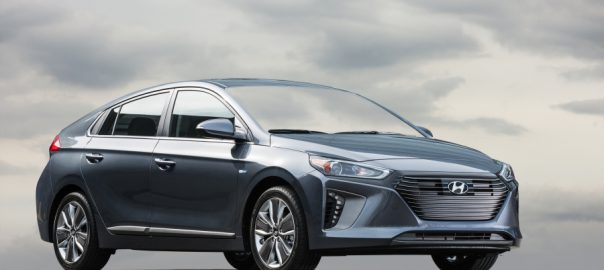The second version of the 2017 Hyundai Ioniq I got to drive was the fully electric model (the plug-in hybrid wasn’t available to all drivers), and although my first thought was that the Ioniq electric only has a 124-mile range (which probably has more to say about our societal conditioning about “range anxiety” than about actual driving habits), I ended up changing my mind about the so-called limitations of that as well by the end of the day.
For my time behind the wheel, I gunned it up hills and from full stops, put the regenerative braking at the lowest level, and generally tried to “drive it like I stole it” (at least as much as I could in traffic, anyway), but after checking the odometer against the estimated range still in the battery, that 124-mile range certainly seemed like a solid number, even for a driver who wasn’t trying to hypermile it.
Before getting behind the wheel, I thought that driving the 2017 Hyundai Ioniq Electric was going to be more exciting to me than the hybrid was, perhaps because it’s truly a contender for the fully electric market, both in price and in efficiency (where it is actually the leader — more on that later), but it turned out that I barely noticed the difference. Sure, there were slight differences in the handling and driving experience, perhaps only due to the different drivetrain and battery, but overall, it felt so much like the same car that I had to keep telling myself “It’s an electric.”
The main difference was the almost complete lack of noise, other than some slight road noise from the tires, and the gear shift was missing (replaced by buttons for selecting drive, reverse, Eco and Sport mode, etc.), and the lack of oomph off the line. The Electric accelerated just fine, and could hold its own in traffic, but it certainly didn’t seem to have the same “launch” feeling that the Hybrid did from a full stop.
One feature that I really liked about the Ioniq Electric was the ability to quickly switch between several levels of regenerative braking, via two paddles on the steering wheel. At the lowest setting, the car drove very similar to a conventional vehicle, with plenty of coasting possible when taking your foot off the accelerator, while at the highest level, the regenerative braking feature allowed for a “single pedal” driving style, which meant that as soon as your foot was off of the accelerator, the car started slowing down quite aggressively — not enough to come to a complete stop, but enough that touching the brake wasn’t necessary when accounting for curves and slowing traffic.
I could see the usefulness of the high level of regen braking when trying to get the most range out of the car, while the lowest level gave you the feel of driving a conventional car — something that might come in handy when transitioning from a conventional or hybrid to a fully electric car.
That said, the Electric had plenty of power for the route we were on (which had no incredibly steep or sustained grades), and wasn’t a stodgy “green car” that sacrificed all of the fun of driving in order to deliver a more sustainable transport option.
As with the Hybrid, for the first half of our time with the Electric, my co-pilot drove it mostly in Eco mode, so when I got in the driver’s seat, I put it in Sport mode and kept it there, with the same aim as before — to see if I could put some holes in the company’s range claim. This time, even with some pedal-to-the-metal takeoffs and punching up hills, we ended our drive of the day with the car giving us a range estimate very much in line with the company’s stated 124 miles after subtracting the miles we’d driven.
Read more: Clean Technica

